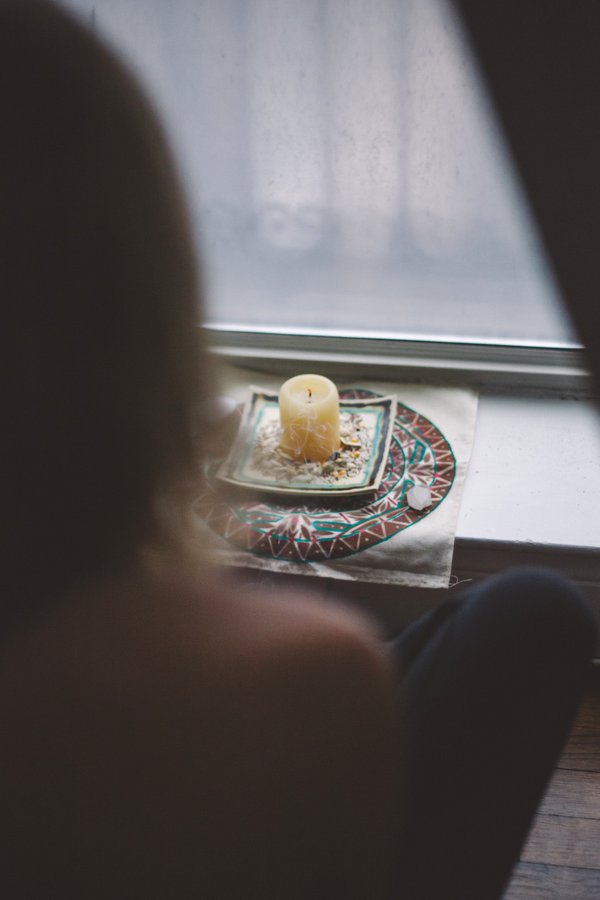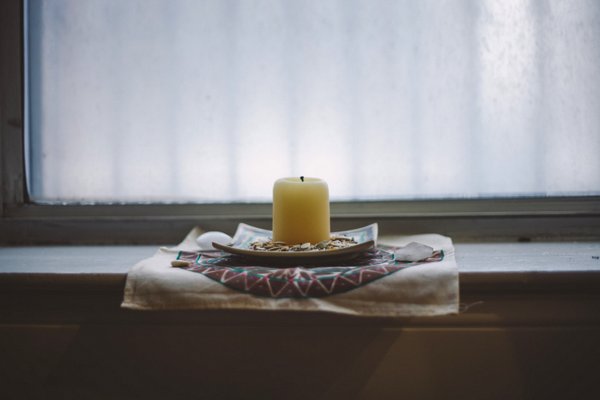As an only child with no coworkers, I’m no stranger to “me time.”
Even with long days alone at the office, it’s still something I need to reset. After the holiday party haul or a wedding weekend away, I’ll find myself craving several nights of kale salad, cashmere pajama pants, and Adam Levine to recover.
But when I started considering the concept of a morning routine, I realized that most of my “me time” was reactionary. It came off the back of a social overdose. Too much raw bar action, white wine, and small talk. Not enough veggies and vegging out in front of mindless vocal talent shows.
What would happen if I turned my me time into something to ward off stress, instead of something I defaulted to when my nerves had already been fried by one too many floor slaps to Shout? Could I find the same solace in a mindfulness exercise as I do in mindless television?
This month I finally committed to finding out the answers to those questions. I wanted to put some healthy intention back into my alone time and make it purposeful and productive for my soul.
In fact, this is something I’ve been talking about now for over a year. You might remember that last fall I did a Wellness Wednesday hangout with Barbara Biziou, the author of The Joy of Ritual. As a pre-wellness project resolution of sorts, I put together this list of daily practices I wanted to add to my life. And a morning routine was one of the main goals.
“Time for yourself can change the entire energy of your day,” Barbara wrote. “Morning ritual helps you begin with peace and optimism, believing in your own ability to cope with whatever awaits you out there in the world.”
I’ve already made some small upgrades to my AM habits. My month of sleep made me recommit to a firm wakeup time, which means hitting the snooze button is no longer the only constant in my morning routine.
I’ve also added in a smattering of other activities from prior wellness challenges. My mornings now begin with a thermometer reading, thanks to my new charting practice. During back month, I set aside fifteen minutes for my pelvic floor exercises while my tea was steeping. And I’ve started making breakfast more frequently to keep up with my high fiber, low sugar protocol—a better way to start the day for all of my organs.
But I was experiencing a crowding problem. There wasn’t enough time in the pre-work day for all of these practices, and rarely could I find any consistency from day to day. Which was not good for my resolve.
Routine hard wires our brain and our body. It grounds our lives. And it makes good habits that much less of a beast of burden. Over the course of this year, I’ve learned this the hard way–through my sleep, my eating, and even my bowels. Your body loves a consistent time table.
So this month I tried to perfect the first sixty minutes of my day. I committed to doing three activities, one for my mind (meditation), one for my body (Pilates), and one for my spirit (journaling). For now, I’m going to just share my experience with door A.
Read on for how it went!
From one healthy hedonist to another,
Xoxo
Phoebe
Meditation cleared my mind. Until it didn’t.
When I brought up the topic of meditation at a cocktail party, one of my more stressed out friends wasn’t buying it. “I don’t understand all these people who say that meditation cured their anxiety disorders,” she vented. “I mean, how? Are they using the Headspace app? Because that sure as shit didn’t stop me from having panic attacks.”
An aggressive take on a Zen subject. But I did kind of get it. I used to have a similar cynical outlook on quick fix meditation.
I tried apps. I tried Deepak. I tried a weird hypnosis exercise. None of them really gave me the mental tools to wrestle my brain temporarily to the ground. And lord knows, I didn’t have the biceps to easily do it on my own. So finally, I went the more structured route of finding a teacher–one who had, indeed, cured his own anxiety disorder with meditation–to hold my hand through the process.
The first group meditation I did in Ben Turshen’s class was a game changer. Afterwards, I finally understood the benefits viscerally, and not just because he had spent the previous hour telling me about them. I experienced the mental calm and the body high. I felt the relaxation and the focus. Colors were brighter. Lines at the grocery store less annoying. Not even the ever-winding beach ball of death on my computer could get me down.
My new found patience may have been, in part, a product of exhaustion. Ben said that people tend to feel some fatigue when they first start mediating—a natural product of your body shedding all the tension it’s been holding onto for decades. Like exercise, some people get hit immediately by this initial “soreness,” and for others it takes a few days to kick in. And true to my experiences with actual exercise, I found myself falling into bed at 9:30pm, my limbs a collection of helpless noodles.
The biggest leg-up from the DIY approach to meditation was getting a mantra. I now see the power of this little piece of spiritual gibberish.
As those of us with anxiety know intimately, it’s futile to try to control your thoughts. Your brain has the emotional maturity of a toddler; it’s constantly looking for where it’ll get the most unadulterated pleasure. The key is to form a diversion. To lead the mind away from suffering with a trail of berry-flavored fruit snacks.
This is where your spiritual gibberish comes in. (Sanskrit, if we’re getting technical).
As Ben explained, mantras are useful because they bewitch the mind. These ancient phrases were designed to be charming. They might not be the most beautiful-sounding words, just as the most dynamic person at a cocktail party might not be the most pleasant to be around. He may snap his fingers and call the cater waiter garcon. And yet there’s something about that effortless bravado, lack of self-awareness, and slight whiff of douchebaggery that makes him fascinating. Your mantra is like your mind’s Shia LaBeouf; you can’t help but be drawn to it.
With the help of my mantra and several other key tools, I was off to an amazing start. But about a month after the class ended, I lost my meditation mojo.
Every time I sat down, my resolve seemed untenable. Instead of effortlessly bringing my mind back to the mantra, I would end up sitting for twenty minutes thinking about all the mundane worries that popped into my head. I dropped the afternoon meditation altogether and stuck with just twenty minutes in the morning. And eventually even that session started to lose its tenure.
For my month of morning perfection, I recommitted to making meditation a part of my routine. But no matter how committed I was to sitting still for twenty minutes everyday, I couldn’t regain that mind magic I had experienced before.
So what happened? Was it beginner’s luck? Laziness? Or had the power of that group class just fizzled and left me floundering?
As I poured back over book research, I came upon a potential explanation. One that also speaks to why some people have such a hard time wrapping their heads around Headspace apps and other quick meditation tools.
The problem with routine? It trumps ritual.
One of the reasons why rituals are so powerful is that our brain can’t distinguish between an intention and an actual event–which makes the meaning we ascribe to various acts have that much more impact.
This is something Barbara Biziou and I discussed during our interview last year. As she relayed, anything can become a ritual—even the most mundane daily tasks—so long as you set an intention and designate a time and space. Brushing your teeth can feed your soul if you let it.
Rituals can also influence our subconscious mind in a way that creates real results in the present. They strengthen our ability to get tasks done and our resolve to pursue our desires. One of my favorite examples in Barbara’s book is that of the writing shirt. When you put on a uniform, it programs your brain to know that it’s time to get back to work.
Traditions are often passed down, and therefore don’t necessarily have the same consciousness. And habits have no consciousness at all. They’re just something you do.
The trick is to develop a habit of mindfulness. This is what Dan Harris referred to as “Buddhism’s secret sauce,” in his memoir 10 Percent Happier about taming his anxiety. It’s a tool to recognize what’s going on in your head–or all around you–at any given moment. Mindfulness rituals are like life’s stop signs. They force you to slow down, pause, reflect.
I realized that in my vigilance for crafting a set morning routine, I had lost some of the intention behind my practices. Meditation had become just another thing I had to do. And because I wasn’t mindful about its set purpose, the end result lost its luster.
During our group session, one couple asked about what to do with their dog while they meditated. They worried that he would get yippy if left outside the room, and impatient if kept on the bed when they did their session. Ben’s advice was to keep him close. Animals feed off the energy of their companions. The dog would settle accordingly, and perhaps even appreciate the twenty minutes of calm.
I wondered how much of this was true to my own animal experience. Was I only able to ground myself in the meditation exercise because I was surrounded by ten other humans emanating the same Zen, blissed-out energy?
This was probably part of it. But I think intention played a bigger role than energy and even accountability. With the class, it was clear what we were there for. Not just what we’d be doing–but why we were doing it. Perhaps talking about the benefits of meditation had a placebo effect. But therein lies the power of ritual.
So where does that leave me?
I’m going to keep meditation as part of my morning routine, but try to add some of the ritual back into it. This might mean lighting a candle at the beginning and blowing it out at the end to create firmer context. But it will also mean remembering my intention of focus and relaxation before I start.
And if even that doesn’t work–if I have a day when my mantra gets defeated by the “is this even working?” mental through line–I’ll try to be kind to myself. And remember that twenty minutes of stillness is still a gift.
***
Other than meditation, I’m still trying to choose my perfect morning adventure. Exercise was a total fail. And after trying a few other things in the third slot, I realized that packing in so much threatened to defeat the purpose of my pursuit.
Having that hour to myself in the morning was a luxury. It allowed me time to honor my energies. To set my own pace. To ease into the day before my inbox opened and swallowed me whole.
If you’re trying to maximize your own mornings, I urge you to keep checking yourself. Make sure what you’re committing to doesn’t turn your “me time” pleasure into just another one of the day’s chores.
Have you ever had a wellness practice that was self-defeating like this? Let me know in the comments section!
Also, I’ve decided not to give you a final challenge post for the wellness project. Instead, I’ll be in touch in late December with some overall resolution thoughts for you to take into the New Year. And in the meantime, I have a book to finish!! (Trying to remember to breathe…).



I dont have a consistent morning ritual either..esp these days its been hard for me to get up on my regular schedule. i will start with 5-10 minutes of stretching while my tea steeps. thank you!
ugh the short days are the worst! it’s so hard to get out of bed when it’s dark and cold outside. I feel you. But 10 minutes is still a great start! xo
I really, really want to dig into this more, but right now I can only focus on learning more about cashmere pajama pants.
Oh, Joy. You’re in for such a treat. They are the gift that keeps on giving. I received a pair ten years ago from my dad and remember, at the time, scoffing at the extravagance. But they are worth their weight in GOLD. Mine now are completely ragged on the bottoms. But can’t stop, won’t stop.
In my experience, the following thoughts help even if I don’t feel some sort of improvement during or immediately after meditating:
1) I trust that what I have done is somehow good for me (even if just subconsciously). I don’t think it’s always calming, sometimes stuff comes up. If something comes up, I acknowledge that and try not to judge.
2) Even if I only meditate for two minutes in the morning, I usually feel subtle “lifts”/help throughout the day. My experience is definitely that merely the effort of focusing only on my breathing already helps, even if I don’t reach the “ideal meditation state” during that meditation. (I rarely do these days.)
3) Meditation is a matter of practice. I tell myself that five or ten minutes a day are not much compared to some people who practice much longer each day over a period of years. With time, I will get better. For now, I can still do a bit of something good for me.
I have found the texts of Jon Kabat-Zinn very helpful.
Good wishes + happy holidays.
These are such great reminders Nina. Thank you for sharing! I need to be better about #1, clearly 🙂
Such a beautiful post! Thank you for sharing this with us. I’m sharing this with my friends and family. I usually meditate before going to bed but I would love to make some time for myself every morning. Happy holidays 🙂
Thank you for reading mary francis! Any time spent meditating is better than none at all, so if you have no trouble falling asleep at night afterwards, no need to uproot your routine! I have an easier time with consistency in the morning, as much as I would love a nighttime ritual as well. xoxo
Love this post Phoebe. It is such a great reminder of the importance of intention!
aw, thanks sweet whitney. you’re so great for reading. oxox
We actually never tried a morning meditation. We’ve tried it only in late afternoons (like 7 or 8 pm) after we got back from the office, ate something, relaxed a bit and then said “now we’ll meditate”. Perhaps that’s the reason in worked most of the times, because of the mindfulness behind it like you said. We were focused on the “let’s now have a 20 minutes to ourselves, to relax and balance our soul”. The bad thing is, we didn’t put it in our daily ritual. Life is indeed overwhelming, and 24 hours are never enough. But you reminded us again, that we have to make this time. Since it’s something that does help, we need to see again the big picture.
Thank you for sharing this dear Phoebe!
xoxoxo
do you find you have trouble sleeping when you do it so late? I heard that can be a problem with mediating later in the evening. But either way, better to have it in your routine than not! go you!
Hi Phoebe! No, meditating late actually calms us down and helps us sleep afterwards. Of course every night we also drink a cup of calming herbal tea (Yogi Tea is a brand we particularity prefer) which also helps, when we get to bed.
I love Yogi tea too! Glad you get it over there!